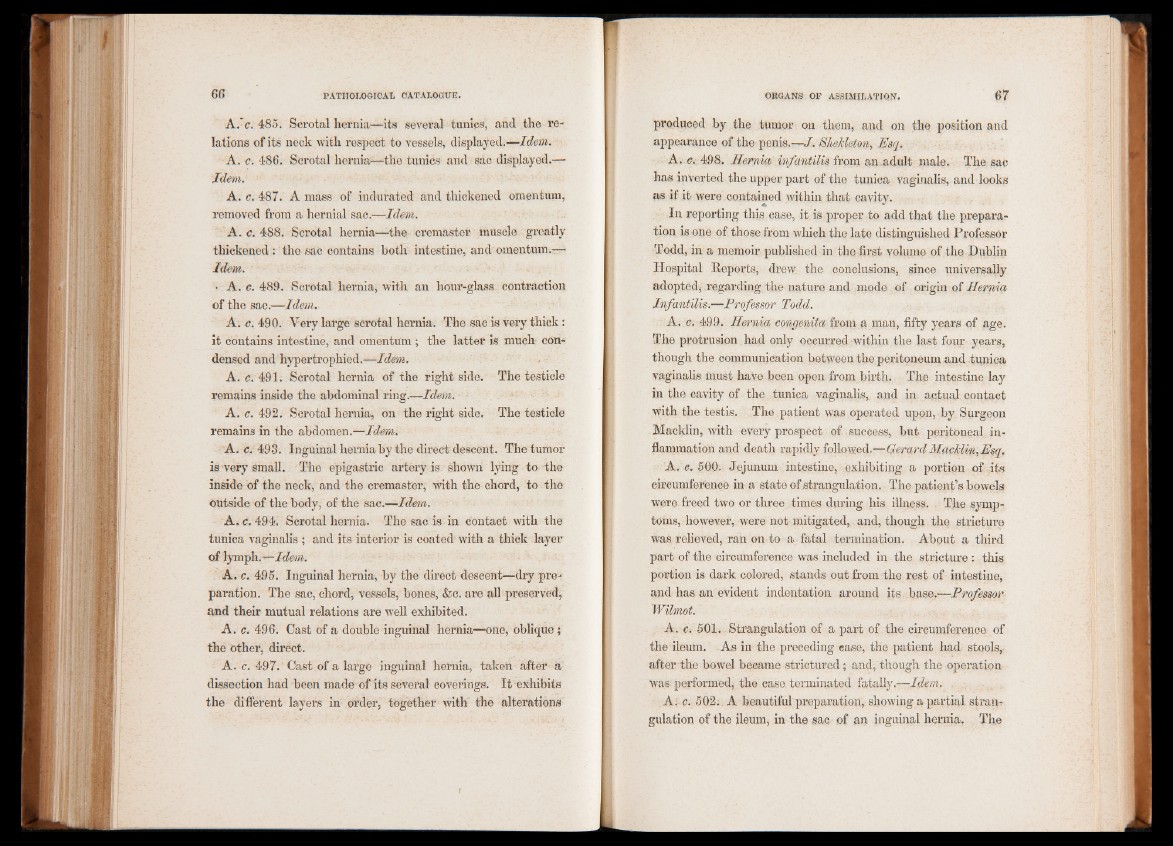
A. c. 485. Sei’otal hernia—its several tunics, and the relations
of its neck with respect to vessels, displayed.—Idem.
A. c. 486. Scrotal hernia—the tunics and sac displayed.—
Idem.
A. c. 487. A mass of indurated and thickened omentum,
removed from a hernial sac.—Idem.
A. <?. 488. Scrotal hernia—the cremaster muscle greatly
thickened : the sac contains both intestine, and omentum.—
Idem.
• A. c. 489. Scrotal hernia, with an hour-glass contraction
of the sac.—Idem.
A. c. 490. Very large scrotal hernia. The sac is very thick:
it contains intestine, and omentum ; the latter is much condensed
and hypertrophied.—Idem.
A. c. 491. Scrotal hernia of the right side. The testicle
remains inside the abdominal ring.—Idem.
A. c. 492. Scrotal hernia, on the right side. The testicle
remains in the abdomen.—Idem.
A. c. 493. Inguinal hernia by the direct descent. The tumor
is very small. The epigastric artery is shown lying to the
inside of the neck, and the cremaster, with the chord, to the
Outside of the body, of the sac.—Idem.
A. c. 494. Scrotal hernia. The sac is in contact with the
tunica vaginalis ; and its interior is coated with a -thick layer
of lymph.—Idem.
A, c. 495. Inguinal hernia, by the direct descent—dry preparation.
The sac, chord, vessels, bones, &c. are all preserved,
and their mutual relations are well exhibited.
A. c. 496. Cast of a double inguinal hernia—one, oblique;
the other, direct.
A. c. 497. Cast of a large inguinal hernia, taken after a
dissection had been made of its several coverings. It exhibits
the different layers in order, together with the alterations
produced by the tumor on them, and on the position and
appearance of the penis.—J. SheMeton, Esq.
A. c. 498. Hernia infantilis from an .adult male. The sac
has inverted the upper part of the tunica vaginalis, and looks
as if it were contained within that cavity.
In reporting this case, it is proper to add that the preparation
is one of those from which the late distinguished Professor
Todd, in a memoir published in the first volume of the Dublin
Hospital Reports, drew the conclusions, since universally
adopted, regarding the nature and mode of origin of Hernia,
Infantilis.—Professor Todd.
A. c. 499. Hernia congenita from a man, fifty years of age.
The protrusion had only occurred within the last four years,
though the communication between the peritoneum and tunica
vaginalis must have been open from birth. The intestine lay
in the cavity of the tunica vaginalis, and in actual contact
with the testis. The patient was operated upon, by Surgeon
Macklin, with every prospect of success, but peritoneal inflammation
and death rapidly followed-—Gerard Macklin, Esq.
A, c. 500. Jejunum intestine, exhibiting a portion of its
circumference in a state of strangulation. Thepatient’s bowels
were freed two or three times during his illness. The symptoms,
however, were not mitigated,. and, though the stricture
was relieved, ran on to a fatal termination. About a third
part of the circumference was included in the stricture : this
portion is dark colored, stands out from the rest of intestine,
and has an evident indentation around its base.'—Professor
Wilmot.
A. c. 501. Strangulation of a part of the circumference of
the ileum. As in the preceding ease, the patient had stools,
after the bowel became strictured; and, though the operation
was performed, the case terminated fatally.—Idem. ,
A; c. 502. A beautiful preparation, showing a partial strangulation
of the ileum, in the sac of an inguinal hernia. The